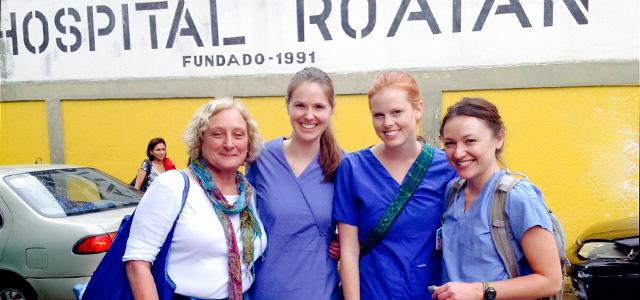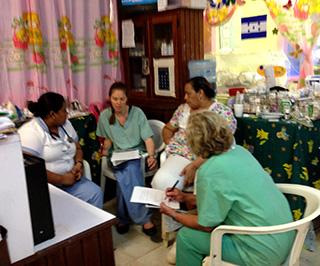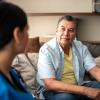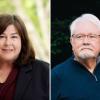
From left: Mary Lynch, Ella Harris, Nichole Mosher and Ashley Ramirez at the Public Hospital Roatán in Honduras
Building Trust, Improving Care in Roatán
In March 2014, after nine hours of travel, we arrived in Roatán, Honduras. We were exhausted but also energized by the beauty this island has to offer.
Many of our fellow passengers were on vacation or a honeymoon, eagerly anticipating their first piña coladas on the beaches of this island off the coast of mainland Honduras. In contrast, we were nervously anticipating our arrival at the Public Hospital Roatán (PHR), uncertain of how the staff and administration would receive us.
We were there to complete a needs assessment for the nursing element of a project known as Global Interprofessional Pediatric Education (GIPE), an interdisciplinary program among UCSF schools of dentistry, medicine, nursing and pharmacy in partnership with the nonprofit Global Healing, which has had a long and steady presence on the small island. Generally, GIPE aims to improve resources, education and the efficiency of processes at PHR; our specific focus was to improve nursing education.
To that end, Ella Harris and UCSF School of Nursing faculty member Mary Lynch had been at PHR in September 2013 to begin exploring the creation of a culturally acceptable method for continuing nursing education at PHR. As part of the process, Lynch had taught two nursing care classes – on diabetes and newborn care – for which Harris did the translation to Spanish.
Seeking Acceptance at PHR
PHR is the one free public hospital on Roatán; there are also two private, for-profit hospitals. We arrived on a bustling Monday morning. Lines weaved every which way, a semiorganized chaos throughout the hallways. We were strangers – people were clearly curious about our presence – as we made our way to the office of the nursing supervisor, named Delia.
Thankfully, she greeted us with open arms and immediately began filling us in on the current hospital culture, staff training and background, funding and available resources. She explained the administrative nightmare of running PHR, including the difficulty of getting supplies from the mainland and keeping the nursing staff up-to-date on best practices. Her concerns were obvious, but she also had a vision for the future and was eager to involve UCSF in improving the care at PHR.
 Still, we remained nervous since Delia’s warmth and openness didn’t guarantee the same reception from the pediatric and labor and delivery nurses we would be shadowing; thankfully, that would not prove to be a problem, in part because the respect Global Healing has earned gave us local street cred, something of critical importance when entering any new environment.
Still, we remained nervous since Delia’s warmth and openness didn’t guarantee the same reception from the pediatric and labor and delivery nurses we would be shadowing; thankfully, that would not prove to be a problem, in part because the respect Global Healing has earned gave us local street cred, something of critical importance when entering any new environment.
“Claro que te recuerdo a ti, tu estabas haciendo entrevistas hace seis meses” (“Of course I remember you; you were here doing interviews six months ago”), a pediatric nurse told Ella when she arrived on the ward during that first day. A lively conversation ensued, which gave all of us hope that we really would be building a sustainable partnership with the nurses in Roatán.
That matters because nurturing the budding relationships and building them into a working professional cultural exchange was at the center of what we were doing on this trip. So we sat with nurses on their shifts, spoke with them about nursing, asked questions and responded to theirs.
Medication Administration
In particular, we were concerned with observing medication administration. A group of UCSF pharmacy students were there as well, conducting an inventory of medications and analyzing the supply chain.
Nurses read prescriptions off the small cardboard squares on which they appeared. The nurses would then draw up the medications and dilute them with saline from an IV bag, which the nurses changed only when the saline ran out – a process that highlighted the scarcity of supplies. Then, with an unlabeled syringe, the nurses would walk to the patients’ bedsides and over the span of a couple seconds push the medication into the IV ports; far too often, the children cried throughout the procedure.
This, clearly, was not what we had learned in nursing school, but we needed to figure out how best to address what struck us as a dangerous practice. Gasping in horror or stepping in to correct the practice would violate the trust and relationships we were trying to build. Besides, Delia had made clear to us that her nurses understood evidence-based practice, but things change when you work in a hospital with limited supplies; a divide opens up between what textbooks say to do and what is possible to do.
The fact that there are barriers to appropriately administering medications is an easily identifiable problem, but solving it means being acutely aware of the big picture, especially the structural problems within the system. The reality is the nurses and medical professionals in Roatán want to do what is right and help heal their patients, so our challenge is to understand how we can help make the care safer within the constraints these nurses face – to realistically connect education and practice.
To do so, we first need to accept that at least for the near future we cannot change the structural barriers; instead, we have to persevere and find ways to overcome or work around them. We need to be creative and listen to local leaders like Delia, who gently stressed to us the need to start small, build relationships and be consistent – but also be flexible, because one widely accepted maxim for any global health project is that your ideas and vision will always change.
We started bouncing ideas around with Delia, including conducting bedside rounds, making short training videos for the nurses about specific practices, streaming lectures from UCSF and including the Roatán nurses in class discourse.
The process deepened our education about the challenges often painfully present in global health, which is more than a specialty or a field: It is a way of interacting with the environment. It is about being humble and open to new experience, whether it be trying a new food or learning how nurses administer medication. It is about facilitating an exchange of knowledge and, through this exchange, constructing ways of caring for vulnerable populations.
Personal relationships are at the heart of such pursuits – and those take time to build. We hope, over time, we are building them.
Ella Harris, Nichole Mosher and Ashley Ramirez are all nurses as well as students in UCSF Global Health Sciences and at UCSF School of Nursing in the advanced practice public health and acute care pediatric nurse practitioner programs.



